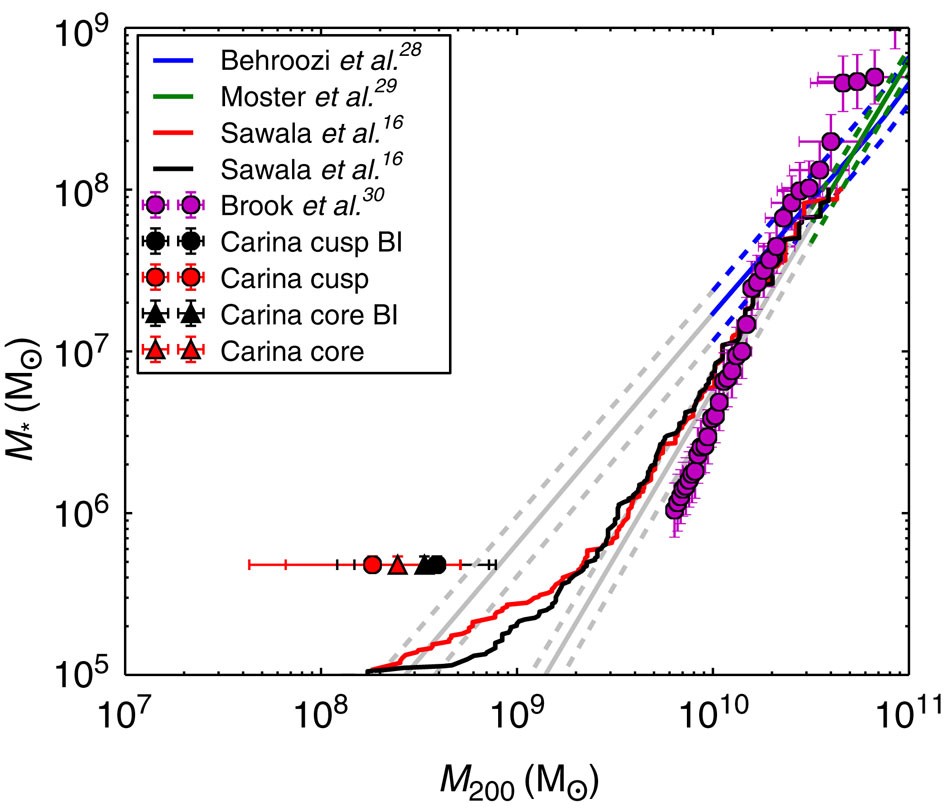In 2006, I received my M.Eng from an inspiring interdisciplinary program (RAMAS), from the Chalmers University of Technology. The program combined four components; radio astronomy and astophysics, earth system science, signal processing and microwave engineering, space technologies; allowing the graduates to specialise in any of these areas after the graduation.
Afterwards, I focussed on computational astrophysics and mainly on statistical modelling and simulations of dwarf spheroidal galaxies (dSphs), first as a Marie Curie Reseach Fellow at the University of Leicester, then as a postdoctoral researcher at the Leibniz Institute for Astrophysics in Potsdam.
Dwarf Galaxies
Dark matter
Dark matter, is the name we give to the predominant form of matter in the Universe. As it does not interact electromagneticly, it is not visible to our telescopes at any wavelength and rather is inferred to indirectly through its gravitational influence.
In the dwarf spheroidal galaxies, the distribution and motion of the stellar populations suggest that they can be the most dark matter dominated systems in the Universe.
Galactic Archaelogy: Dynamical Modelling
Quantifying the amount of dark matter in dwarf spheroidal galaxies present a few challenges.
First, they are potentially not in dynamical equilibrium and their masses change over time as they orbits around larger galaxies closely, losing material to these. The other is the lack of abundant kinematic data, so that the stellar motions and reliable orbital information could be used to model their dynamics and estimating their masses as well as mass loss.
In 2015, we estimated for the first time the pre-infall mass of a dwarf spheroidal galaxy (paper), using tens of thousands of N-body simulations within a Markov Chain Monte Carlo algorithm. N-body simulations calculate the interactions in a multi-particle system (formed by stars and dark matter particles) and follow the evolution of the system through time to observe the final state. For Carina, we constrained the dark matter halo mass to a lower upper bound than found up to that date (core and cusp symbols in the below figure).

Credit: Ural, Wilkinson, Read & Walker, 2015 (Nature Communications, 6, 7599).
This work used about 1M core computing hours on UK Astrophysical Fluids Facility and DIRAC
.Galactic Archaelogy: Chemical Abundances
In 1925, a brilliant astronomer, Cecilia Payne showed in her PhD thesis that the most abundant elements in stars were Helium and Hydrogen. Her conclusions were rejected at the time, but it became clear a few years later she was correct.
Starting with Helium and Hydrogen, heavier elements are gradually formed through nuclear fusion in the stars. The abundance of different heavy elements and their ratio to iron can give us information about the formation environment and conditions as well as the evolutionary paths.
In 2014, we analysed and modelled the stellar spectra in the Ursa Minor Dwarf Spheroidal galaxy, indicating that it had a very long period (5 billion years) of low efficiency star formation.
Radio Astronomy
Radio waves are a type of electromagnetic radiation just like the visible light. They are formed by charged particles and carry energy. However, the energy these two types of radiation carry and the wavelengths they propagate with are very different from each other and they need different types of detectors. While our eyes, and optical telescopes for the visible spectrum, to detect waves in the radio spectrum, we need to use antennas.
Compared to optical astronomy, radio Astronomy is a much newer field that started with the discovery of a persistent background noise in the radio antennas of the Bell Laboratories in 1030s by radio engineer Karl Jansky. The noise was coming from the centre of the Milky Way, likely from what we today know to be a black hole.
A typical radio telescope is likely to have a dish like parabola shape. Today we are also using and building arrays of radio telescopes of which the sensitivity and resolution are increased significantly due to radio interferometry (check out VLA).
Some of My Favourite Astronomy Sites
- Astronomy Picture of the Day. It is a NASA hosted website that has been publishing an astronomy related picture every day since 1995. Just brilliant.
- Hubble Space Telescope. Both the images and their science section is full of interesting information.